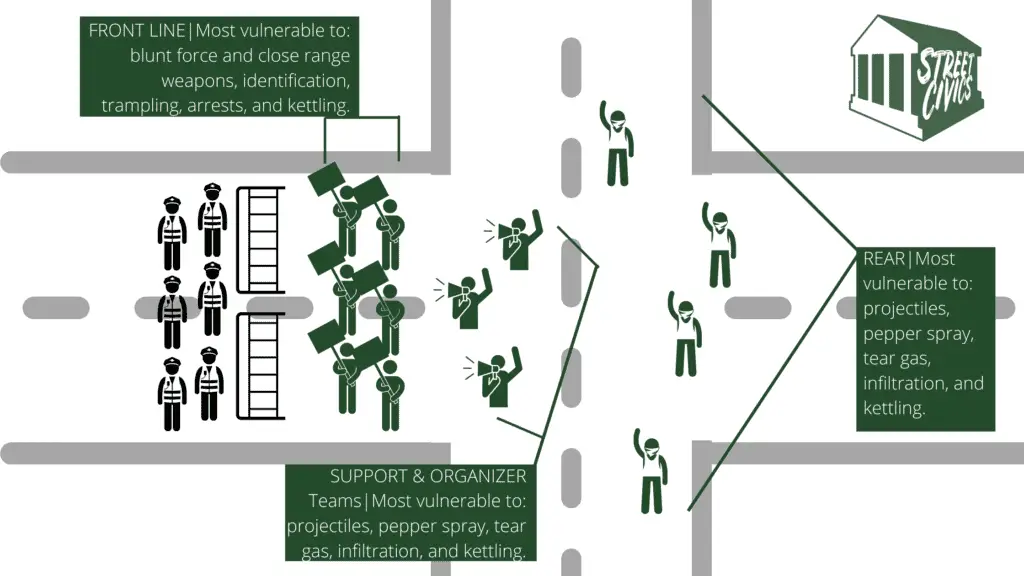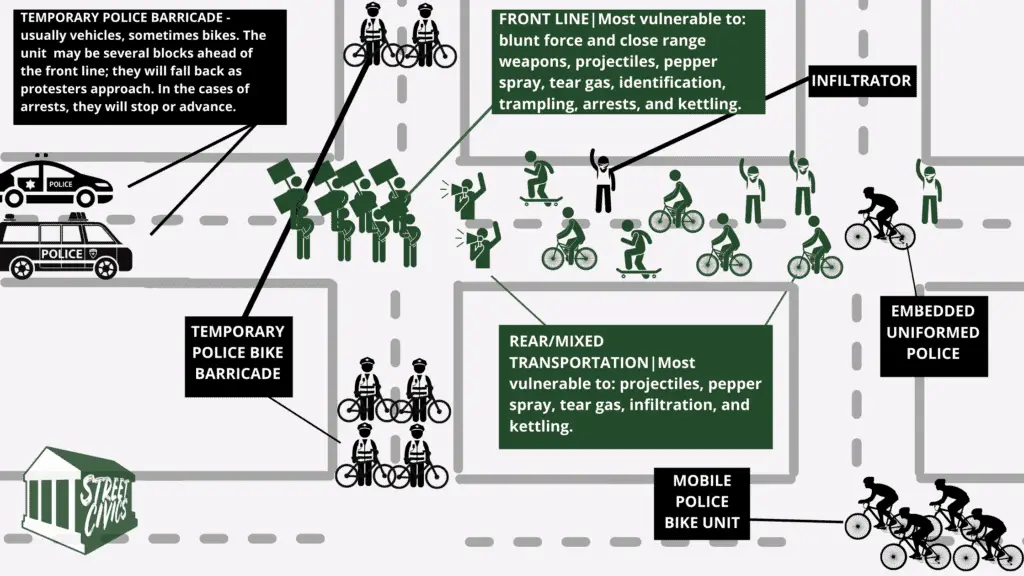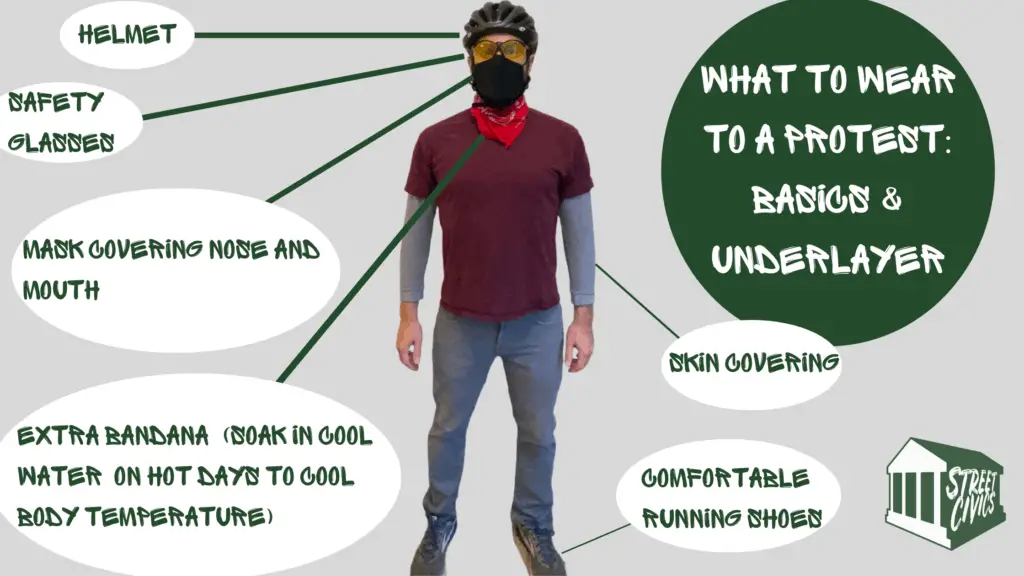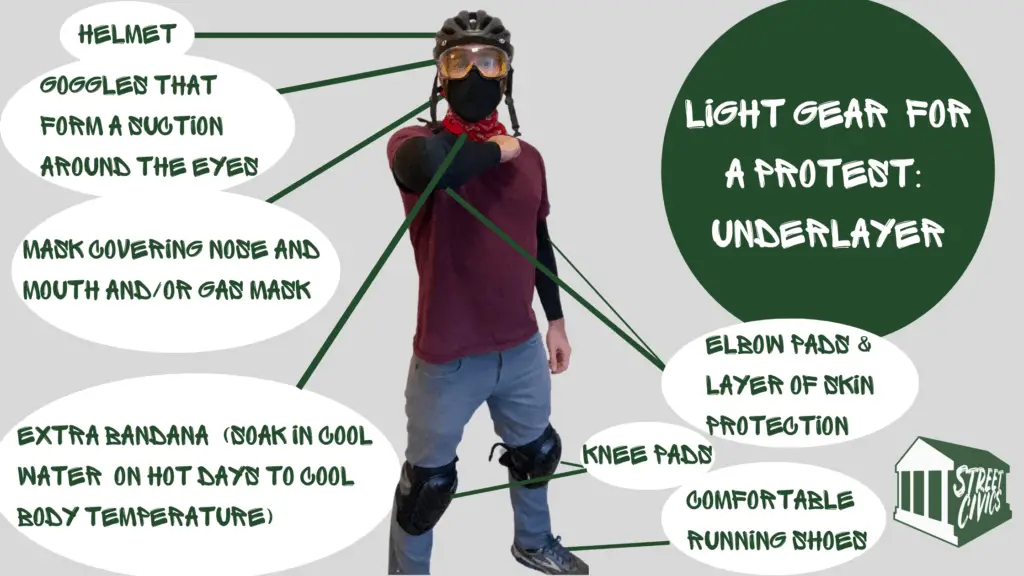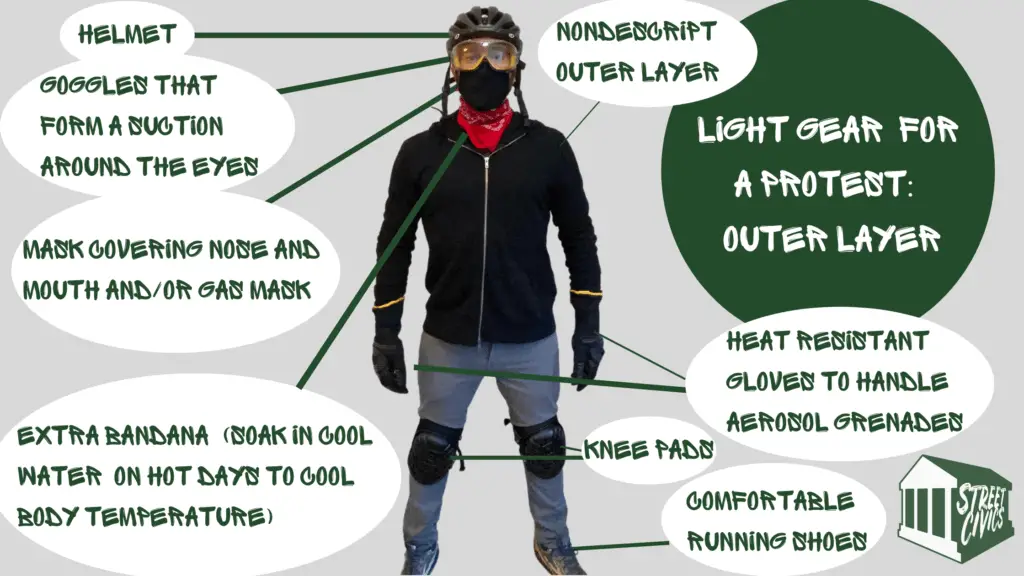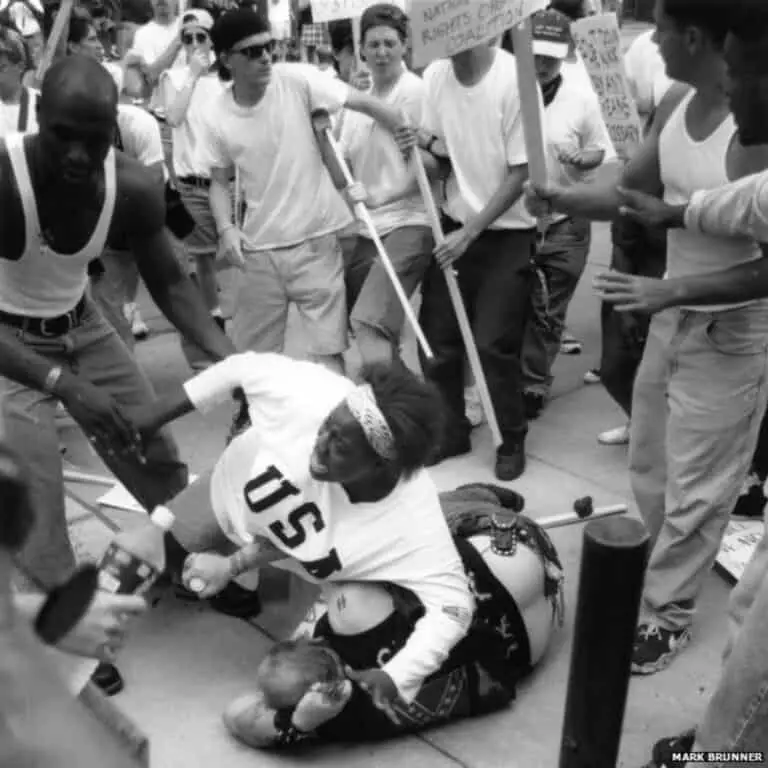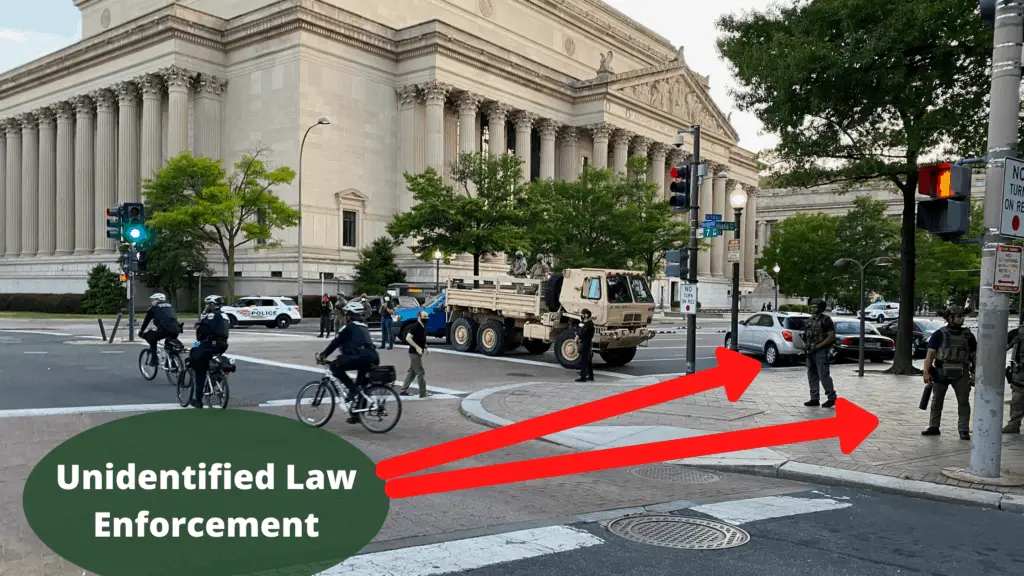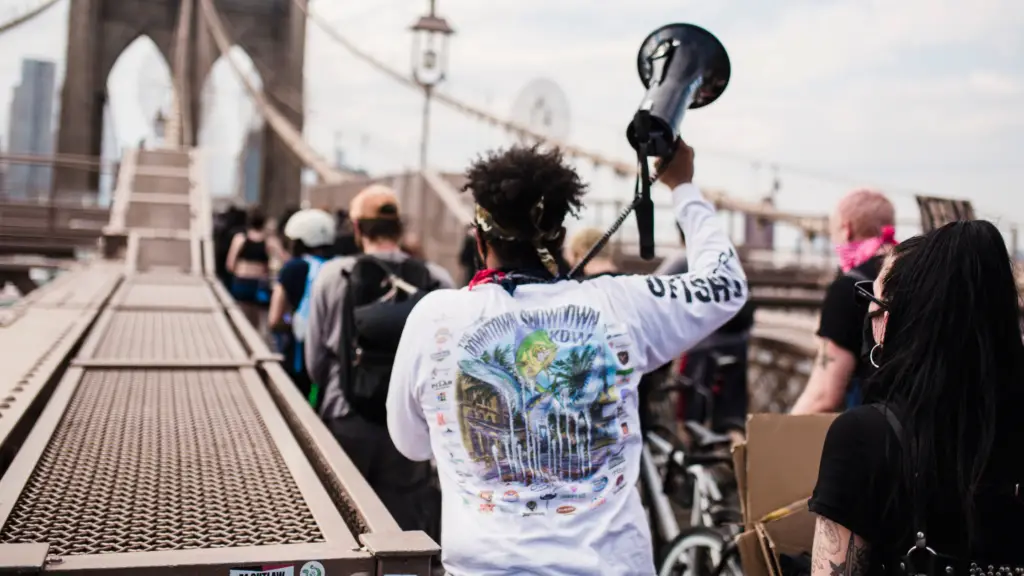
This is a user-friendly guide to effective protesting. Topics include individual involvement, what to know before joining a protest, what to wear, on-the-ground tactics, encounters with law enforcement, and more.
Organizers and interested readers may also want to read the companion piece to this article – An Organizer’s Guide to Protests and Political Change, which outlines the logistics of organizing a demonstration, strategies, tactics, and how to leverage the event for political change.
What to Know Before Joining a Protest
Setting “Rules of Engagement”
What to Wear to a Protest
What To Bring to a Protest
Protest Activities
Crowd & Time Management
Using Space: Stand Like a Rock or Be Like Water
Disrupters & Infiltration
Law Enforcement & Crowd Control Tactics
Riot Control Formation
Kettling or Corralling
Crowd Control Weapons: Protection & Wound Care
Unidentified Law Enforcement
Individual Involvement
What to Know Before Joining a Protest
Individual protesters can be most helpful to long term movements when they carefully think through their involvement beforehand. Setting personal “rules of engagement” can help activists participate peacefully and mindfully, which is critical to a movement’s long term success.
“Rules of engagement” typically refers to directives that set the parameters for military involvement, but the term is useful when thinking about participation in group activities. Often protests are in response to breaking news or events and people quickly take to the streets. A quick response time can help increase visibility, but protesters can gain longer-term advantages by taking just a few extra minutes to think through how they will participate before jumping in.
Setting personal “rules of engagement” before joining a protest can help demonstrators avoid getting sucked into the herd mentality; it can also help activists maintain composure in tense scenarios. Keeping in mind that protests are most effective when they are peaceful, activists should always remember that their actions reflect on the entire movement.
Protesters who set clear answers to the following questions and commit their answers to memory are likely increasing the chances that their own involvement will be safe, effective, and are improving the movement’s long-term chances of success.
Setting “Rules of Engagement”
Questions to consider before joining a protest (these questions assume protesters can articulate a clear reason as to why they want to participate).:
- What is my intended outcome?
- It’s good to have clear goals when getting involved in protests both at the personal and movement level. At the personal level, defining intended outcomes might also include the level of commitment. For example, “I will protest every Tuesday until the mayor overturns the policy.” Or, “I will participate in the movement’s march in the capital every year until the bill is passed.”
- Where and when will I participate?
- At times, protests may be happening in multiple neighborhoods at the same time or the protests may move throughout the city. Choosing a specific time and place to meet up with the crowd is best to have, at minimum, a few hours in advance. Joining protests hastily can leave activists susceptible to making emotion-based decisions and groupthink.
- Protesters should remain mindful of where they are in the city and understand how to get home. If demonstrators find themselves in an unfamiliar part of the city, it’s best to try to stick with the crowd until they have their bearings. Leaving the group too quickly could leave protesters vulnerable to harassment or arrest.
- How will I get to and from the protest?
- Protesters should choose their form of transportation wisely.
- Rideshares can be good options if available, but can’t be counted on for a quick getaway.
- Taking a personal vehicle can be convenient, but protesters have to deal with parking; it also comes with risks like damage to the car or having to leave the car in an unfamiliar part of the city.
- Public transportation can also be convenient but does make protesters vulnerable to easy tracking through things like ticket purchases. If possible, always pay in cash or loose change when taking public transportation to and from demonstrations. After and during protests, many methods of public transportation such as trains or subways become a natural meeting ground for activists and law enforcement – sometimes with ugly results.
- Biking can be a good option for urban settings and the bike can be used as a barrier or as general protection when necessary. However, bikes can be cumbersome if the majority of the crowd is on foot; bikes usually can’t be taken into dense crowds or to the front lines during marches.
- Scooters, skateboards, electric devices, etc. can be good in urban areas and close to home. These devices are usually less clumsy than bikes and can offer some protection as well. If electric, battery life impacts the activist’s participation and, it could become too bulky to carry into dense crowds even if it’s manual.
- Walking, if possible, can be one of the best ways to meet up with a protest as it allows for easy getaways, zero tracking, flexibility, and also leaves open the option of getting other transportation on the way home. The drawback is that it can be limiting in terms of involvement. Protesters should keep in mind that walking will typically be more physically taxing than protesters might realize – especially on their way home after the adrenaline rush wears off.
- Protesters should choose their form of transportation wisely.
- How long will I stay?
- Defining a time to end protesting for the day – before joining – can help demonstrators stay involved over the long term by keeping up their stamina and increasing their sense of accomplishment. There is empowerment when protesters define their “shift” at the front lines and commit to a certain amount of action. For example, “I will protest from 6 pm until 10 pm tonight.” It also likely reduces the chances that protesters will get into unexpected situations or get carried away by the herd mentality.
- What activities will I participate in?
- Protesters should try to think through what types of activities they would get involved in before arriving. Protesters should not take civil disobedience lightly and should note that violence and property damage can greatly reduce public support for protests. Protesters also need to be mindful of the organizers and impacted communities. Avoid driving crowd chants or decisions if you are there in solidarity, are not an organizer, or are not part of the impacted community.
- Activists may want to think about their activities in terms of the physical space they will want to occupy. Protests often develop in one of several physical layouts such as the examples below.
Front Line Formation
The first layout involves a wall or “front line” of protesters often facing police forces and/or a building or object. Protesters can think of the intensity of involvement in terms of the positions they occupy in these types of layouts. Notice protesters in each area face risks and that these formations center around confrontation. These layouts can make for good media but do risk confrontation spiraling out of control.
Speaker’s Circle
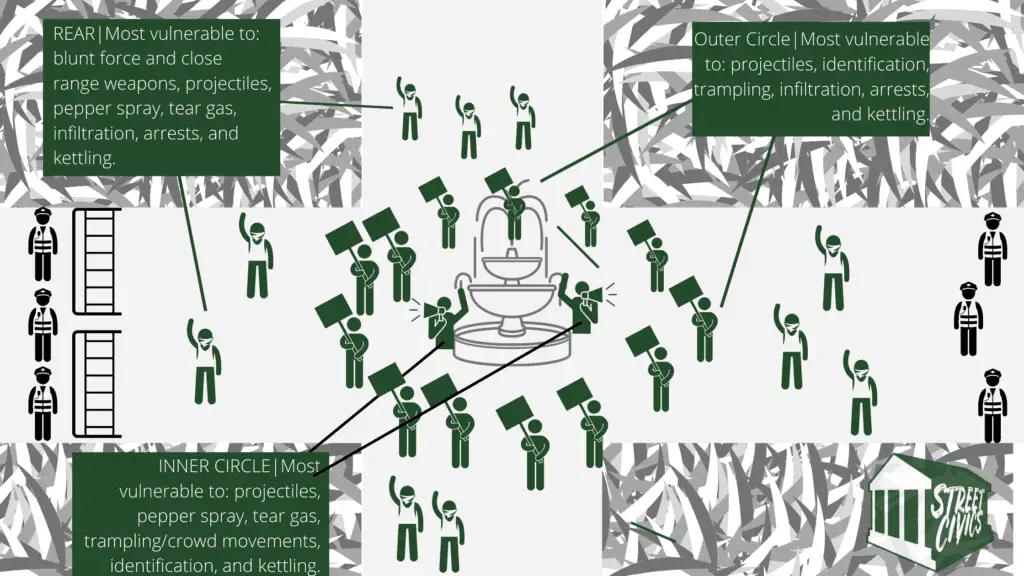
The second layout is a circle often surrounding a person, organizer, or object. These formations are usually done in parks or public squares. Protesters can think of their involvement in terms of where they stand in relation to the center. Notice on the diagram above that activists on the outside of the circle become the frontlines in a sense. Encircling or kettling practices are more difficult in these arrangements.
Marching Protests
- Do I need to be concerned about surveillance?
- Protesters should take surveillance seriously. At a minimum, activists should be mindful of any social media posts and should not post pictures of someone else’s face without their permission. Demonstrators may want to forgo using social media altogether unless there is a clear advantage to posting something online and/or a way to post anonymously. If concerns are serious enough, activists may want to put their phones on airplane mode before leaving and only reconnect once safely back home. Keep in mind that if you are in your own community, your phone may automatically connect to wireless networks – this could allow authorities to identify later you.
- Would I talk to the media?
- Journalists can grab people at random during protests and the potential to look foolish is high. Before attending a protest, activists should consider the pros and cons of interacting with the media. If demonstrators determine that they would be willing to interact with the media, think about what you would say. Journalists will likely ask something like “why are you out here today?” or “what are you trying to achieve?” If they ask something you don’t know the answer to, say “I don’t have any insight for you there,” and avoid speaking for “the movement” when you’re not an organizer. See more tips on media engagement here.
- What if I need legal assistance?
- Having the number of an attorney or someone who could help if you find yourself in a legal bind before getting involved in protests should be a no-brainer for activists. It’s a good idea to start with the National Lawyers Guild. If the NLG can’t help you, googling “lawyers for protesters near me” can yield surprising results.
Note that the American Civil Liberties Union has a mobile app called Mobile Justice available on iOS and Android devices to record incidents, access information regarding rights, and request legal assistance.
- Having the number of an attorney or someone who could help if you find yourself in a legal bind before getting involved in protests should be a no-brainer for activists. It’s a good idea to start with the National Lawyers Guild. If the NLG can’t help you, googling “lawyers for protesters near me” can yield surprising results.
What to Wear to a Protest
I’m Joining Today/Tonight
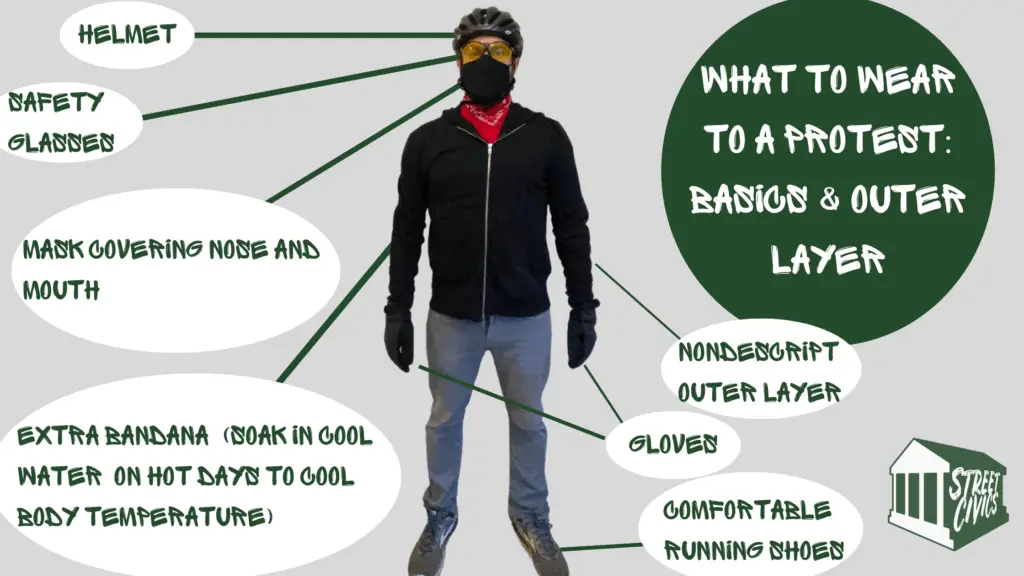
I’m Joining in a Few Days/Weeks
What To Bring to a Protest

Items pictured:
- Prescription medications and/or emergency supplies such as an EpiPen. Even casual participants and bystanders can get caught up in police tactics such as kettling. Protesters should be aware that they may be corralled by police and not permitted to leave for long periods of time, sometimes overnight.
- A small mirror to examine facial wounds and see around objects or corners.
- A small pen and pad of paper for non-digital communication.
- Cash and spare change to use public transportation without using a credit card (which could be used to identify protesters).
- Small flashlights can be lifesavers at night – especially in chaotic environments.
- Extra tissue for wound care or regular use.
- Tweezers for wound care.
- Small first aid kit.
- Snacks and gum especially useful in case protesters are kettled by law enforcement.
- Spare phone charger.
- Drinking water.
- A soapy water solution in a biking or push cap water bottle can be used to flush the eyes in case of pepper spray – use hand soap, dish soap, or shampoo. (See Crowd Control Wounds & Weapons: Protection & Treatment for more.)
- Your message.
- A change of clothes with nondescript items and a spare bandana.
On-the-ground Tactics
As emphasized throughout this post, peaceful protests are the most likely to succeed. So, developing a levelheaded culture among participants is important. Demonstrators should look for ways to build solidarity among protesters while also showing a message of hope and unity to the general public. This can be easier said than done sometimes as activists tend to divide themselves among the die-hards and those that participate less often or less visibly. This tendency is a major mistake that can split movements, alienate potential supporters, and lead to failure.
Protest cultures that develop an unstated hierarchy of participation are often seen as unapproachable, unreasonable, and tend to fail to gain public support. Organizers and protesters, then, should welcome all levels of participation and help develop a culture of understanding that welcomes all amounts of support. Building internal unity can be a real struggle for movements, but is vital to long term success. Organizers should look to nip any disharmony in the bud.
Protest Activities
Many of the most influential and memorable protests have brought people together for a unique activity. For example, the Candlelight Revolution in South Korea (which successfully ousted then-President Park Geun-hye) brought millions of people together for a candlelight vigil. Similarly, the Singing Revolution brought together the people of the Baltic States under the pretext of singing at community festivals to oust the Soviet Occupation.
There are many common ground tactics, but organizers should not feel limited to what’s come before them. Drawing inspiration from the local culture like the examples above can help increase public support. In fact, research conducted by Erica Chonwerth and Maria J. Stephan indicates that low participation barriers can be one of the biggest determinants of a movement’s success. Organizers should then seek to make the activity low cost in every sense of the word (e.g. risk, money, ability, time, materials, etc.). Below is a chart of common activities.
Types of Protest Actions
| Action | Description | Notes |
|---|---|---|
| Rallies and speeches | Rallies and speeches are typically organized demonstrations with a loose agenda and set speakers. | This tactic puts the organizers at the center. While effective with the right personalities, it can also drown out other voices if organizers aren’t mindful. (For megaphones or audio equipment see this Street Civics resource.) |
| Marches | Marches are organized processions of demonstrators that often start at a convenient rally location and then parade activists slowly toward a strategic or symbolic location. | Marches are a good way for protesters to cover more ground and reach a larger audience by moving through town; this strategy can help both with building public support and by encouraging participation from bystanders. These types of protest can often provide dramatic imagery for the media as well. |
| Chanting & holding space | Chanting is usually a default for groups that have gathered together spontaneously, in response to an event, or if protests have carried on for prolonged periods of time. | Random chants and generally holding space are part of any demonstration, but are not necessarily enough to distinguish a movement. If protests are prolonged, organizers may want to consider introducing distinct demonstrations of solidarity like unique gestures, singing or lighting candles to help build an identity for the movement. |
| Candles and vigils | Vigils are public ceremonies that invite supporters to light a candle at a specified time and/or place. | This tactic can start spontaneously, but requires organizing for larger crowds. Often, candles and sources of fire need to be passed out or around. More space than usual is needed to give people room (they may need to sit down), but the more space that’s used the bigger impression it makes. |
| Singing and celebrations | Singing and celebrations can be a form of protest in the right context. The optimistic attitude of this tactic may help gain public sympathy and support. | These tactics appear on some scale at many demonstrations. However, they can also become a distinct feature of a movement in certain circumstances. Celebrations may have one of the lowest participation barriers and could help attract mass participation. |
| Cacerolazo (or casserole) | A Cacerolazo or casserole is a demonstration where protesters bang on pots and pans or other items to make noise and call attention to an issue. | These tactics have been used in the West since the 1830s. The tactic has a low participation barrier as most people have something they can bring to make noise with. This tactic can be a memorable and defining feature for a movement and may help grab media attention. |
| Burma Shave | Burma Shaves put demonstrators along roadsides or thoroughfares with signage and public message tools. (The term comes from an old shaving cream company that was famous for using roadside signs as an advertising device.) | Burma Shaves are great options to cover more ground with less demonstrators. Organizers who have low participation, might consider splitting protesters into small teams around town to cover more ground. Clever signage and messaging is crucial for this technique. |
| Human Chains | Human chains have participants link arms and from a line which can either form a barrier or simply link people across places (sometimes across cities or even countries) in a show of unity. | Human chains are well-known but still underutilized tactics of protests. The more space activists can link the more it moves the general public and policymakers. |
| Street and Guerilla Theater | Theater can be a powerful way for activists to make a point with devices like satire. Street theater is often organized in advance, while guerilla theater can be surprise performances in unlikely places. | Theater can be an effective tool for organizers. However, in order to carry out theater well, organizers should consult and work with local artists and actors. |
| Blocking traffic and disruptions | Blocking traffic on major roads, peacefully stopping economic flows and/or disrupting daily life for the community are tactics sometimes used by protesters. | These tactics can call attention to an issue quickly but can also alienate potential supporters who are inconvenienced by the disruption. This tactic is directly confrontational and some rogue participants may destroy property, which can decrease a movement’s chance of success. Organizers should also be aware of any relevant local laws. |
| Banner dropping and public messages | Activists sometimes organize a banner drop or an unveiling of a message in a public space. | These tactics can be effective ways to get messages across. Beware that authorities often respond by trying to take down the message which can result in altercations. This tactic takes a bit of planning to do well. |
| Picketing | Picketing assembles activists outside a strategic location and/or outside an event, usually with the hope of dissuading others from attending the event or going inside. | Picketing is a tried and true tactic of trade unions, however, it’s a versatile tactic that can be relatively effective even with low numbers. |
| Lock-on | Lock-ons are when protesters secure themselves to a stationary object in order to make it difficult for them to be removed by authorities. | These tactics can require some real sacrifice and put protesters in very vulnerable positions. Demonstrators using these tactics should have a clear plan and should think carefully about how they will meet their basic needs, go to the bathroom, etc. |
| Sit-in | Sit-ins are tactics where protesters occupy a space and refuse to leave. | These tactics are effective and were employed with successful results during the civil rights movement. They are also less risky than some tactics like Lock-ons and have a lower participation barrier. |
| Die-in or lie-in | Die-ins or lie-ins are when presters pretend to be dead as a group in a public space to raise awareness for an issue. | These tactics also have a low participation barrier and can be part of a larger protest scene. They can be effective visuals. |
| Love-in | Love-ins are peaceful demonstrations centered on meditation, love, music, and even sex or drugs. | These tactics were popular in the 1960s with hippie counterculture. They offer low participation barriers, but organizers should keep in mind that the more relatable the scene is, the more likely they will gain public support. |
For more inspiration see:
- Seven Fundamental Strategies for Grassroots Movements
- 7 Classic Examples of Advocacy
- 9 Textbook Examples Of Grassroots Activism
Crowd & Time Management
Protests can be ripe ground for groupthink and herd mentality situations. Organizers can help maintain a peaceful environment by using the following tips:
- Set the tone: proactive communication in a confident, loud voice is the best way to keep crowds from spiraling out of hand. Most people will respect organizers and the impacted communities when they are proactively directing chants and the general actions of the crowd.
- Have some activities in mind: if possible, come prepared with ideas for collective action and demonstrations of solidarity.
- Set boundaries, but issue orders: repeating to the crowd that this is a peaceful protest and that violence and vandalism only hurt the cause helps deter rogue participants from unleashing their anger in unconstructive ways.
- If there is an emergency or crowd panic, yell “WALK, DON’T RUN!”: Running in a crowd can result in people getting knocked over and trampled. If there is a threat, emergency, and/or law enforcement response causing alarm or panic, do all you can to ensure people calmly exit. Getting people to walk swiftly to exits could be the difference between life or death for some.
- Use time tactically – list build: In between speeches and chants, try to collect signatures and emails to build a list of supporters.
Using Space: Stand Like a Rock or “Be Water”
Occupying space is a chief component of demonstrating. Protesters should understand what their movement’s relation to space is. Some movements, for example, may need to occupy specific areas, while others may be able to move about a city to escape arrest or police responses. Tactics should be considered based on the movement’s relationship with space.
The Hong Kong protests that began in 2019 have been dubbed the “water revolution” because of the movement’s strategy to “be water.” The metaphor is attributed to Bruce Lee (though, it has roots in Taoist philosophy – something every organizer should be familiar with). Lee once stated, “be formless, shapeless, like water. Water can flow or it can crash – be water, my friend.”
Protesters have adopted this axiom to guide their demonstrations. At times, the protesters will “scatter like mist” or “be hard like ice” depending on what the situation calls for. Notice that the movement is not tied to a specific location which allows activists to use this fluid strategy.
Conversely, some protests are centered around the use of land or resources and protesters may find they need to occupy a specific area to be effective. This scenario arises frequently for environmental movements that may seek to protect land or stop harmful construction projects. One example of this was the Dakota Access Pipeline protests in which demonstrators sought to protect the land from pipeline construction.
The Standing Rock tribe led much of the resistance to the pipeline and, in 2016, police violently cleared an activist encampment that stood in the way of the pipeline’s construction. The police used a water cannon against peaceful protesters in cold weather. The act shocked many and support for the demonstrators grew as a result of police using force against peaceful protesters.
Activists that find themselves in situations that require them to ‘stand like a rock’ should be aware that they face more potential of police violence than those who can move about freely and carry on protests in multiple locations. This awareness should spur organizers to encourage participants to wear protective gear and ensure there is medical assistance on standby.
Crucially, organizers who anticipate the potential for police violence may want to publically document attempts at de-escalation and dialogue. Documenting any efforts to resolve situations peacefully on the part of protesters may help bolster public support.
Disrupters & Infiltration
Protesters should be aware that law enforcement and/or opposing political movements may attempt to infiltrate a group of demonstrators. Outside actors may try to pose as an ally and/or insight violence or vandalism. This can be a deliberate strategy to undermine the credibility of peaceful protest movements – precisely because the movement represents a threat to certain political agendas.
If an infiltrator is uncovered, it can prompt aggressive responses from the crowd. Organizers and activists should quickly call out the person and demand they leave. However, it is vitally important this be done in a measured way – so as not to stir up demands for retribution. These situations can be tense but turning things violent is exactly what the opposition wants from the crowd. Using a peaceful, yet forceful response will increase public support.
In 1996, for example, an anti-KKK demonstration taking place in Ann Arbor, Michigan was infiltrated by a member of the KKK. The situation quickly escalated as protesters surrounded the man and demanded that they “kill the Nazis.” In a heroic act, Keshia Thomas (an African American woman) jumped in front of the white supremacist pleading with the protesters not to hurt him.
She later remarked that “nobody deserves to be hurt, especially not for an idea.” Her bravery was famously captured by Mark Brunner and the photos became a significant boost to the credibility of the movement as a whole.
Law Enforcement & Riot Control Tactics
Protesters and organizers should be aware that riot control tactics have become increasingly advanced. Military equipment given away to police departments in recent years has also given local police forces weapons meant for war and not necessarily riot control. Nonetheless, the tactics employed in modern-day riot control are designed to minimize injuries and to disperse protesters. Below are typical riot control methods that protesters may encounter.
Riot Control Formation
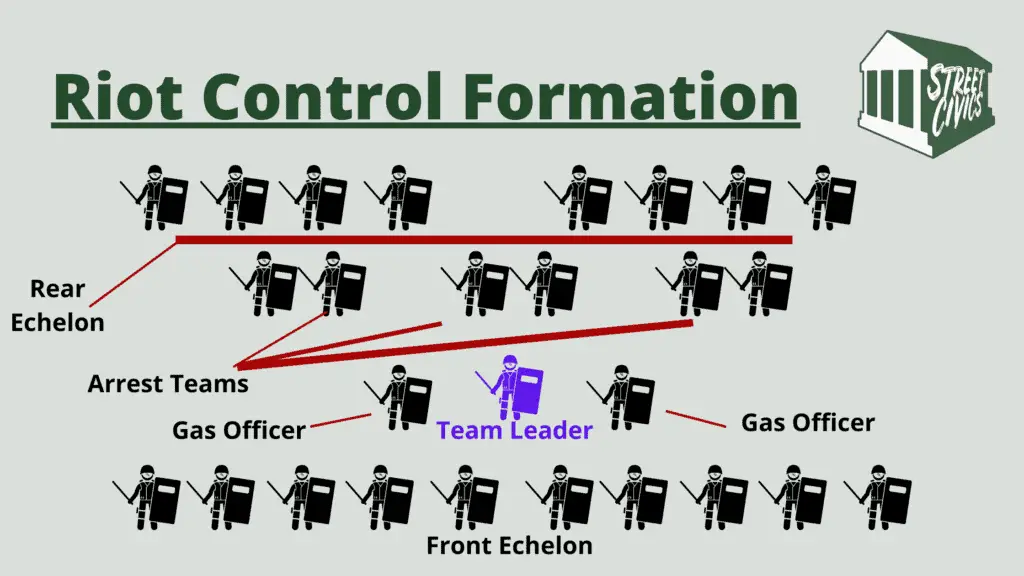
During protests and riots, teams of 10 – 12 officers deploy in a square formation with an arrest and a command team in the middle. The formation is versatile, allowing the team to quickly respond to threats from all sides, advance, or take up a defensive position.
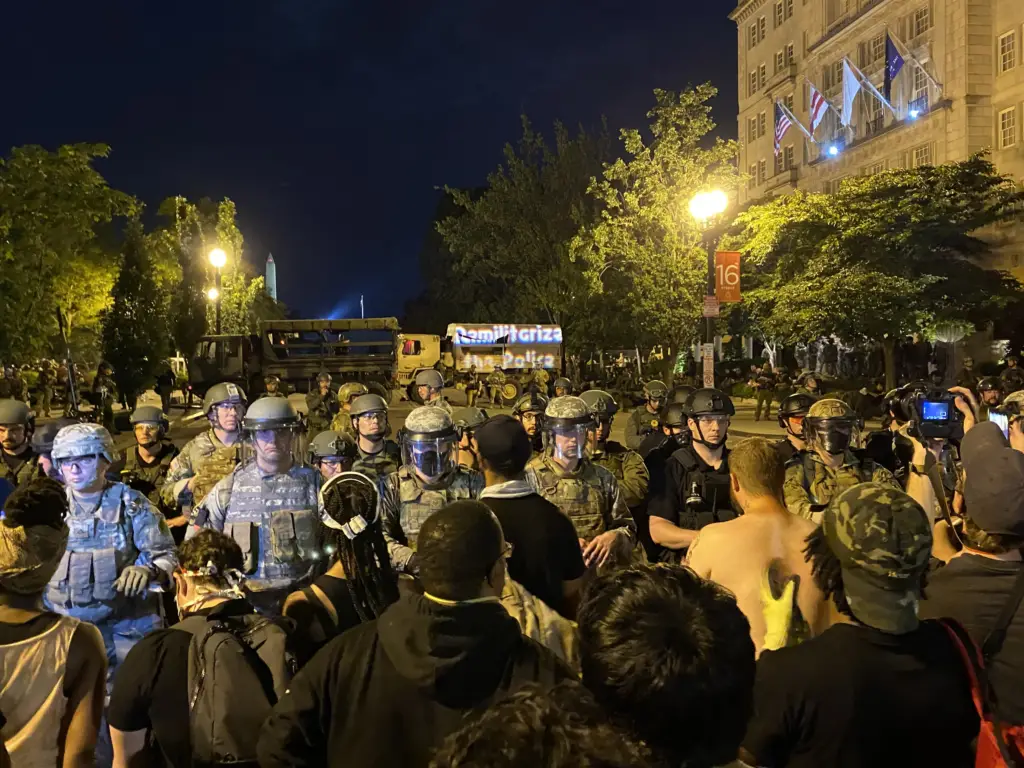
The team is meant to move as a unit and, if one portion of the team is attacked, the rest of the formation responds by providing cover. This tactic is also meant to give law enforcement flexibility in their approach. For example, officers may adopt a more passive stance and leave ample spacing between officers. In many cases, the formation will purposely leave an escape route to usher stray protesters through.
If the formation begins advancing and encounters protesters who refuse to leave, the front echelon (or front line) is supposed to open and encircle the remaining demonstrators. Once the front echelon fully encircles the protesters, the arrest team moves in. This process is meant to be repeated until the area is cleared.
Kettling or Corralling
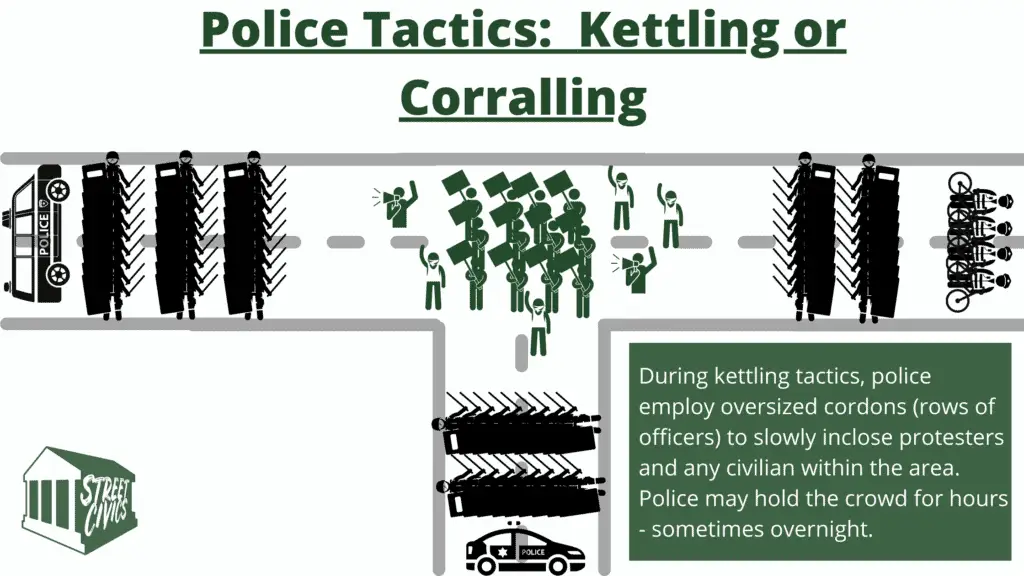
“Kettling” is a crowd control tactic used by police; it uses large cordons (or rows of officers) to entrap and corral protesters. Often these tactics result in long stand-offs in which the police contain the demonstrators in a small location for long periods – sometimes overnight.
In theory, the tactic is meant to give police the ability to slowly release small groups of protesters over a period of time, however, this is not always done in practice. The tactic has become controversial and police often sweep up innocent bystanders as they advance through city streets.
Protesters should be aware that these tactics can come swiftly and without warning – often surprising casual participants. Recording videos and taking pictures of the incident may be helpful either for real-time online activism or for later documentation. Protesters should always carry extra prescription medications and/or necessary emergency treatments such as an EpiPen when joining a protest in case they are kettled by police.
Crowd Control Weapons: Protection & Wound Care
NOTE: The chart below is for informational purposes only. Street Civics does not provide medical advice. Always consult with a medical professional when treating wounds. Readers should use their best judgment when seeking to protect their bodies from various weapons; information provided in the protection/mitigation column should be understood as provisional in nature and may not prevent injuries or wounds in all circumstances.
Common Injuries to Protesters
| Injury | Protection/Mitigation | Wound Care |
|---|---|---|
| Impact wounds from batons or projectiles | Fashioning a shield may help prevent or mitigate a blow from a baton. Activists might consider wearing a helmet; shoulder pads, knee pads, elbow pads, and/or using a garbage lid, bike, skateboard, road sign, or other solid objects to prevent blows to the body. | Impact wounds vary greatly depending on the force behind the blow and where on the body the impact was received. Treat head injuries seriously and seek medical attention immediately. Ice bruises to the body and try to immobilize any extremity that was hit. Take Tylenol and ibuprofen for pain relief. (DO NOT TAKE ASPIRIN IN CASE OF INTERNAL BLEEDING). |
| Pepper spray | Goggles, gas masks, gloves, and a thin layer of skin protection. | Pepper spray may cause a boiling or bubbling sensation in the eyes. It may cause temporary blindness, extreme pain, and respiratory issues. The effects may last from 30 to 45 minutes. Pepper spray is oil based and can spread easily; areas of the body that have been hit by the substance should not be touched or it will likely spread the substance. If hit by pepper spray, blink rapidly to help flush the oil out. Wash the infected area – including the eyes – with hand soap, shampoo, or dish soap and then rinse thoroughly with water. Activists should note that water alone will not remove the pepper spray because water and oil don’t mix at a molecular level. Additionally, some protesters use milk to neutralize the burn, however, because milk is not sterile, it is not a recommended treatment. |
| Tear gas | Goggles, gas masks, gloves, and a thin layer of skin protection. | Tear gas is a chemical powder that can produce a burning sensation in the eyes and on the skin. The chemical agent will eventually settle on the ground. If hit by tear gas, protesters should close their mouth and shut their eyes if possible, try to exit the area quickly and calmly, seek high ground, avoid touching your face and eyes, and wash the agent off your skin with soap and water as soon as possible. Remove glasses or contact lenses with clean hands and rinse eyes with pure water for several minutes. When possible, take off any clothing that was exposed to the agent and leave it outdoors to air out. Take a cold shower , keeping eyes and mouth closed as much as possible to avoid inhaling any trace amounts of the agent; take care to wash the hair well. Avoid taking baths as the agent will remain in the water. |
Common Weapons Used on Protesters by Police
| Round or Weapon | Protection/Mitigation | Wound Care |
|---|---|---|
| Baton – made of hardwood or metal; around 24 – 42 inches long; meant to be aimed at the arms and legs. | Fashioning a shield may help prevent or mitigate a blow from a baton. Activists might consider wearing a helmet; shoulder pads, knee pads, elbow pads, and/or using a garbage lid, bike, skateboard, road sign, or other solid objects to prevent blows to the body. | Impact wounds vary greatly depending on the force behind the blow and where on the body the impact was received. Treat head injuries seriously and seek medical attention immediately. Ice bruises to the body and try to immobilize any extremity that was hit. Take Tylenol and ibuprofen for pain relief. (DO NOT TAKE ASPIRIN IN CASE OF INTERNAL BLEEDING). |
| Tasers shoot two metal probed darts and deliver electrical currents that disrupt muscle control and immobilize the target. | Tasers can usually shoot up to 15 feet and can penetrate clothing that’s up to 2 inches thick. Both probes must hit the target for the electrical current to work. Stopping the probes from penetrating the skin is the best defense. Some fabrics may also prevent the projectiles from delivering the current. Lining clothes with carbon tape, for example, may disrupt the current and leave the target unharmed. Professional grade equipment uses a polyester which also neutralizes the current. | A Taser is a conducted electrical weapon (CEW) and is intended to incapacitate an individual with an electrical shock, which causes involuntary muscle contractions. The shock is painful and the recipient will not be able to control their body for the duration of the shock. Afterwards, those who are shot by a taser may need a few minutes to recover total control over their body. Targets may or may not require medical treatment. There is some debate over the effects of CEWs and recipients of CEW shocks may want to seek medical treatment. |
| Stun guns are close range conducted electrical weapons (CEWs) that, like Tasers, shock targets and immobilize them by producing involuntary muscle contractions with an electrical current. Note the difference between stun guns and Tasers is that Tasers shoot metal projectiles to deliver the electrical current, while stun guns deliver the current directly from the gun. | Some fabrics may prevent the stun gun from delivering the current. Lining clothes with carbon tape, for example, may disrupt the current and leave the target unharmed. Professional grade equipment uses a polyester which also neutralizes the current. | Stun guns are conducted electrical weapons (CEWs) and are intended to incapacitate an individual with an electrical shock, which causes involuntary muscle contractions. The shock is painful and the recipient will not be able to control their body for the duration of the shock. Afterwards, those who are shot may need a few minutes to recover total control over their body. Targets may or may not require medical treatment. There is some debate over the effects of CEWs and recipients of CEW shocks may want to seek medical treatment. |
| Wood baton rounds are blunt-force ammunition; 40-mm wooden cylinders that are accurate and long-range. | Activists might consider wearing a helmet; shoulder pads, knee pads, elbow pads, goggles and/or using a garbage lid, skateboard, road sign, or other solid objects as shields from oncoming fire. | Impact wounds vary greatly depending on the force behind the blow and where on the body the impact was received. Treat head injuries seriously and seek medical attention immediately. Ice bruises to the body and try to immobilize any extremity that was hit. Take Tylenol and ibuprofen for pain relief. (DO NOT TAKE ASPIRIN IN CASE OF INTERNAL BLEEDING). |
| Rubber baton rounds are blunt-force ammunition; 40-mm rubber cylinders that are accurate and long-range. | Activists might consider wearing a helmet; shoulder pads, knee pads, elbow pads, goggles and/or using a garbage lid, skateboard, road sign, or other solid objects as shields from oncoming fire. | Impact wounds vary greatly depending on the force behind the blow and where on the body the impact was received. Treat head injuries seriously and seek medical attention immediately. Ice bruises to the body and try to immobilize any extremity that was hit. Take Tylenol and ibuprofen for pain relief. (DO NOT TAKE ASPIRIN IN CASE OF INTERNAL BLEEDING). |
| Foam baton rounds are blunt-force ammunition; 40-mm foam cylinders used for short range. These rounds may be fired at the ground near advancing targets, causing the rounds to break apart, dispersing more projectiles. | Activists might consider wearing a helmet; shoulder pads, knee pads, elbow pads, goggles and/or using a garbage lid, skateboard, road sign, or other solid objects as shields from oncoming fire. | Impact wounds vary greatly depending on the force behind the blow and where on the body the impact was received. Treat head injuries seriously and seek medical attention immediately. Ice bruises to the body and try to immobilize any extremity that was hit. Take Tylenol and ibuprofen for pain relief. (DO NOT TAKE ASPIRIN IN CASE OF INTERNAL BLEEDING). |
| Bean bag rounds are square (less accurate) or triangular (more accurate) shaped bean bags that can be used at long-distances. | Activists might consider wearing a helmet; shoulder pads, knee pads, elbow pads, goggles and/or using a garbage lid, skateboard, road sign, or other solid objects as shields from oncoming fire. | Impact wounds vary greatly depending on the force behind the blow and where on the body the impact was received. Treat head injuries seriously and seek medical attention immediately. Ice bruises to the body and try to immobilize any extremity that was hit. Take Tylenol and ibuprofen for pain relief. (DO NOT TAKE ASPIRIN IN CASE OF INTERNAL BLEEDING). |
| Sponge rounds are bullet-shaped with a sponge tip. They are sometimes loaded with pepper spray or dye to mark individuals for further pursuit or arrest. | Sponge rounds represent multiple threats including blunt force trauma, pepper spray injuries, and general exposure to identification through dyes. Activists might consider wearing a helmet; shoulder pads, knee pads, elbow pads, goggles, gas mask, a thin layer of skin protection, and/or using a garbage lid, skateboard, road sign, or other solid objects as shields from oncoming fire and gas. Activists might also consider bringing a change of nondescript clothing in case they are hit by dye; electrical tape, duct tape, bandanas, loose strips of cloth, or other items may also be useful in covering stains to clothing including shoes. | Impact wounds vary greatly depending on the force behind the blow and where on the body the impact was received. Treat head injuries seriously and seek medical attention immediately. Ice bruises to the body and try to immobilize any extremity that was hit. Take Tylenol and ibuprofen for pain relief. (DO NOT TAKE ASPIRIN IN CASE OF INTERNAL BLEEDING). Pepper spray may cause a boiling or bubbling sensation in the eyes. It may cause temporary blindness, extreme pain, and respiratory issues. The effects may last from 30 to 45 minutes. Pepper spray is oil based and can spread easily; areas of the body that have been hit by the substance should not be touched or it will likely spread the substance. If hit by pepper spray, blink rapidly to help flush the oil out. Wash the infected area – including the eyes – with hand soap, shampoo, or dish soap and then rinse thoroughly with water. Activists should note that water alone will not remove the pepper spray because water and oil don’t mix at a molecular level. Additionally, some protesters use milk to neutralize the burn, however, because milk is not sterile, it is not a recommended treatment. |
| Stinger rounds are small rubber pellets that disperse on impact. | Activists might consider wearing a helmet; shoulder pads, knee pads, elbow pads, goggles and/or using a garbage lid, skateboard, road sign, or other solid objects as shields from oncoming fire. | Impact wounds vary greatly depending on the force behind the blow and where on the body the impact was received. Treat head injuries seriously and seek medical attention immediately. Ice bruises to the body and try to immobilize any extremity that was hit. Take Tylenol and ibuprofen for pain relief. (DO NOT TAKE ASPIRIN IN CASE OF INTERNAL BLEEDING). |
| Pepperball rounds are pellets containing pepper spray often shot from modified paintball guns. The pepper spray disperses on impact and is meant to get in the eyes, nose, and mouth of targets. Note that, if children are present, these pellets are sometimes filled with water instead in order to get people to believe they have been hit by pepper spray. | Activists might consider wearing a helmet; shoulder pads, knee pads, elbow pads, goggles, gas mask, a thin layer of skin protection, and/or using a garbage lid, skateboard, road sign, or other solid objects as shields from oncoming fire and gas. | Impact wounds vary greatly depending on the force behind the blow and where on the body the impact was received. Treat head injuries seriously and seek medical attention immediately. Ice bruises to the body and try to immobilize any extremity that was hit. Take Tylenol and ibuprofen for pain relief. (DO NOT TAKE ASPIRIN IN CASE OF INTERNAL BLEEDING). Pepper spray may cause a boiling or bubbling sensation in the eyes. It may cause temporary blindness, extreme pain, and respiratory issues. The effects may last from 30 to 45 minutes. Pepper spray is oil based and can spread easily; areas of the body that have been hit by the substance should not be touched or it will likely spread the substance. If hit by pepper spray, blink rapidly to help flush the oil out. Wash the infected area – including the eyes – with hand soap, shampoo, or dish soap and then rinse thoroughly with water. Activists should note that water alone will not remove the pepper spray because water and oil don’t mix at a molecular level. Additionally, some protesters use milk to neutralize the burn, however, because milk is not sterile, it is not a recommended treatment. |
| Aerosol grenades are metal canisters that hold pepper spray or tear gas. They are thrown like normal grenades but are rarely thrown directly into crowds as they are prone to cause panic. These weapons are typically used to prevent or direct protesters’ movements and/or provide a barricade to law enforcement. | Activists might consider wearing a helmet; shoulder pads, knee pads, elbow pads, goggles, gas mask, a thin layer of skin protection, heat resistant gloves (used to move the grenade) and/or using a garbage lid, skateboard, road sign, or other solid objects as shields from oncoming fire and gas. Organizers may consider having “firefighter teams” stationed behind the front lines. The team can cover any tear gas delivery systems with traffic cones or similar objects that direct the smoke into a small chimney or completely covers the object; the team then pours water down the hole/chimney and douses the grenade to help neutralize it. | Pepper spray may cause a boiling or bubbling sensation in the eyes. It may cause temporary blindness, extreme pain, and respiratory issues. The effects may last from 30 to 45 minutes. Pepper spray is oil based and can spread easily; areas of the body that have been hit by the substance should not be touched or it will likely spread the substance. If hit by pepper spray, blink rapidly to help flush the oil out. Wash the infected area – including the eyes – with hand soap, shampoo, or dish soap and then rinse thoroughly with water. Activists should note that water alone will not remove the pepper spray because water and oil don’t mix at a molecular level. Additionally, some protesters use milk to neutralize the burn, however, because milk is not sterile, it is not a recommended treatment. Tear gas is a chemical powder that can produce a burning sensation in the eyes and on the skin. The chemical agent will eventually settle on the ground. If hit by tear gas, protesters should close their mouth and shut their eyes if possible, try to exit the area quickly and calmly, seek high ground, avoid touching your face and eyes, and wash the agent off your skin with soap and water as soon as possible. Remove glasses or contact lenses with clean hands and rinse eyes with pure water for several minutes. When possible, take off any clothing that was exposed to the agent and leave it outdoors to air out. Take a cold shower , keeping eyes and mouth closed as much as possible to avoid inhaling any trace amounts of the agent; take care to wash the hair well. Avoid taking baths as the agent will remain in the water. |
| Ferret rounds are meant to break through windows or wooden barricades and release tear gas, pepper spray, or dyes. These rounds are typically used to flush people out of buildings or enclosures and/or to mark individuals for further pursuit or arrest. | Ferret rounds represent multiple threats including blunt force trauma, pepper spray and tear gas injuries, and general exposure to identification through dyes. Activists might consider wearing a helmet; shoulder pads, knee pads, elbow pads, goggles, gas mask, a thin layer of skin protection, and/or using a garbage lid, skateboard, road sign, or other solid objects as shields from oncoming fire and gas. Activists might also consider bringing a change of nondescript clothing in case they are hit by dye; electrical tape, duct tape, bandanas, loose strips of cloth, or other items may also be useful in covering stains to clothing including shoes. Organizers may consider having “firefighter teams” stationed behind the front lines. The team can cover any tear gas delivery systems with traffic cones or similar objects that direct the smoke into a small chimney or completely covers the object; the team then pours water down the hole/chimney and douses the grenade to help neutralize it. | Impact wounds vary greatly depending on the force behind the blow and where on the body the impact was received. Treat head injuries seriously and seek medical attention immediately. Ice bruises to the body and try to immobilize any extremity that was hit. Take Tylenol and ibuprofen for pain relief. (DO NOT TAKE ASPIRIN IN CASE OF INTERNAL BLEEDING). Pepper spray may cause a boiling or bubbling sensation in the eyes. It may cause temporary blindness, extreme pain, and respiratory issues. The effects may last from 30 to 45 minutes. Pepper spray is oil based and can spread easily; areas of the body that have been hit by the substance should not be touched or it will likely spread the substance. If hit by pepper spray, blink rapidly to help flush the oil out. Wash the infected area – including the eyes – with hand soap, shampoo, or dish soap and then rinse thoroughly with water. Activists should note that water alone will not remove the pepper spray because water and oil don’t mix at a molecular level. Additionally, some protesters use milk to neutralize the burn, however, because milk is not sterile, it is not a recommended treatment. Tear gas is a chemical powder that can produce a burning sensation in the eyes and on the skin. The chemical agent will eventually settle on the ground. If hit by tear gas, protesters should close their mouth and shut their eyes if possible, try to exit the area quickly and calmly, seek high ground, avoid touching your face and eyes, and wash the agent off your skin with soap and water as soon as possible. Remove glasses or contact lenses with clean hands and rinse eyes with pure water for several minutes. When possible, take off any clothing that was exposed to the agent and leave it outdoors to air out. Take a cold shower, keeping eyes and mouth closed as much as possible to avoid inhaling any trace amounts of the agent; take care to wash the hair well. Avoid taking baths as the agent will remain in the water. |
| Dye rounds are meant to mark targets with a dye so they can be pursued and targeted. Dyes are typically delivered via sponge rounds, pepperball rounds or ferret rounds. | Activists might consider bringing a change of nondescript clothing in case they are hit by dye; electrical tape, duct tape, bandanas, loose strips of cloth, or other items may also be useful in covering stains to clothing including shoes. | Impact wounds vary greatly depending on the force behind the blow and where on the body the impact was received. Treat head injuries seriously and seek medical attention immediately. Ice bruises to the body and try to immobilize any extremity that was hit. Take Tylenol and ibuprofen for pain relief. (DO NOT TAKE ASPIRIN IN CASE OF INTERNAL BLEEDING). |
| Gas rounds typically disperse pepper spray or tear gas and may be delivered by sponge rounds, pepperball rounds, aerosol grenades, ferret rounds or other means. Often, these rounds have effects on those who deploy the rounds too as the gas can cover a larger area and is subject to shifting winds. | Activists might consider wearing a helmet; shoulder pads, knee pads, elbow pads, goggles, gas mask, a thin layer of skin protection, and/or using a garbage lid, skateboard, road sign, or other solid objects as shields from oncoming fire and gas. Organizers may consider having “firefighter teams” stationed behind the front lines. The team can cover any tear gas delivery systems with traffic cones or similar objects that direct the smoke into a small chimney or completely covers the object; the team then pours water down the hole/chimney and douses the grenade to help neutralize it. | Pepper spray may cause a boiling or bubbling sensation in the eyes. It may cause temporary blindness, extreme pain, and respiratory issues. The effects may last from 30 to 45 minutes. Pepper spray is oil based and can spread easily; areas of the body that have been hit by the substance should not be touched or it will likely spread the substance. If hit by pepper spray, blink rapidly to help flush the oil out. Wash the infected area – including the eyes – with hand soap, shampoo, or dish soap and then rinse thoroughly with water. Activists should note that water alone will not remove the pepper spray because water and oil don’t mix at a molecular level. Additionally, some protesters use milk to neutralize the burn, however, because milk is not sterile, it is not a recommended treatment. Tear gas is a chemical powder that can produce a burning sensation in the eyes and on the skin. The chemical agent will eventually settle on the ground. If hit by tear gas, protesters should close their mouth and shut their eyes if possible, try to exit the area quickly and calmly, seek high ground, avoid touching your face and eyes, and wash the agent off your skin with soap and water as soon as possible. Remove glasses or contact lenses with clean hands and rinse eyes with pure water for several minutes. When possible, take off any clothing that was exposed to the agent and leave it outdoors to air out. Take a cold shower , keeping eyes and mouth closed as much as possible to avoid inhaling any trace amounts of the agent; take care to wash the hair well. Avoid taking baths as the agent will remain in the water. |
| Water cannons are often mounted on trucks and deliver a high velocity stream of water. Modern water cannon trucks have multiple cannons on top and can shoot in every direction. | Activists might consider wearing a helmet; shoulder pads, knee pads, elbow pads, goggles, gas mask, a thin layer of skin protection, and/or using a garbage lid, skateboard, road sign, or other solid objects as shields from water cannons. | Impact wounds vary greatly depending on the force behind the blow and where on the body the impact was received. Treat head injuries seriously and seek medical attention immediately. Ice bruises to the body and try to immobilize any extremity that was hit. Take Tylenol and ibuprofen for pain relief. (DO NOT TAKE ASPIRIN IN CASE OF INTERNAL BLEEDING). |
| Dogs are intimidating and largely unaffected by tear gas. They are often used by police during protests. | Activists might consider wearing a helmet; shoulder pads, knee pads, elbow pads, goggles, and other protective equipment. Never look an attacking dog in the eyes, stand sideways to make a narrower target, and try offering a false target for the dog. For example, removing an arm from a sleeve of a shirt or sweater and dangling it may attract the dog. If the dog bites the fasle target, remove it from the body and slowly back away from the area. Activists should protect the face, throat, and chest; keep hands clenched into fists to protect the fingers. The safest part of the body to receive a dog bite is the forearm or shin. Activists should keep in mind that there may be legal consequences to using force against police dogs. | If bitten by a dog, do not pull away as it may make the wound worse. Dog bites can cause serious injury and victims may need to seek medical treatment if the wound is deep, the bleeding does not stop, and/or there are signs of infection. For immediate treatment, stop any bleeding; keep the injured part of the body elevated; wash the wound carefully with soap and water; wrap a sterile bandage around the wound and apply antibiotic ointment daily. |
Unidentified Law Enforcement
In general, federal officers are not required to identify themselves and local police regulations are set by each municipality. Unidentified law enforcement represents a serious threat to the safety of peaceful protesters both legally and physically. The practice has become increasingly criticized.
During the protests sparked by the killings of George Floyed and Breonna Taylor, various federal agents arrived in areas with heavy demonstrations and refused to identify themselves. This made the situation increasingly dangerous for several reasons. Civilians and oppositional political activists often appeared in military-style equipment confusing the issue of who was actually law enforcement. Activists risked personal safety by complying with any orders as imposters could easily force demands on peaceful protesters.
Further, in these scenarios, real law enforcement officers likely escape accountability as it is much more difficult to track who is handling arrest cases or involved in incidents. Allowing anonymity within law enforcement ranks is generally associated with police states and dictatorships (such as Augusto Pinochet’s rule over Chile) because officers are not held responsible for their treatment of civilians and prisoners.
Law enforcement officers are given qualified immunity, which is a legal doctrine meant to prevent government officials from being held personally liable for constitutional violations. The legality around law enforcement not identifying themselves does depend on circumstances and may be challengeable in court in the case of peaceful protests.
If approached by someone claiming to be law enforcement but refusing to identify themselves, activists might consider the following actions:
- immediately record or attempt to document the event;
- state clearly (while recording, if possible) something to the effect of “the current environment is confusing and I have reasonable doubt that you are law enforcement. If you are law enforcement, please identify yourself and your agency”;
- get the attention of third parties such as friends or bystanders, have them start recording, and help find out where they are taking you;
- ask where they are taking you, if you are being arrested, and, if so, what for (attempt to get as much information from them as possible about your situation and where you are going);
- remember that you do have the right to remain silent;
- stay calm and try not to escalate emotions;
- speak with an attorney as soon as possible.
—-
For more, check out the companion piece to this post: An Organizer’s Guide to Protests and Political Change.
Other resources:

